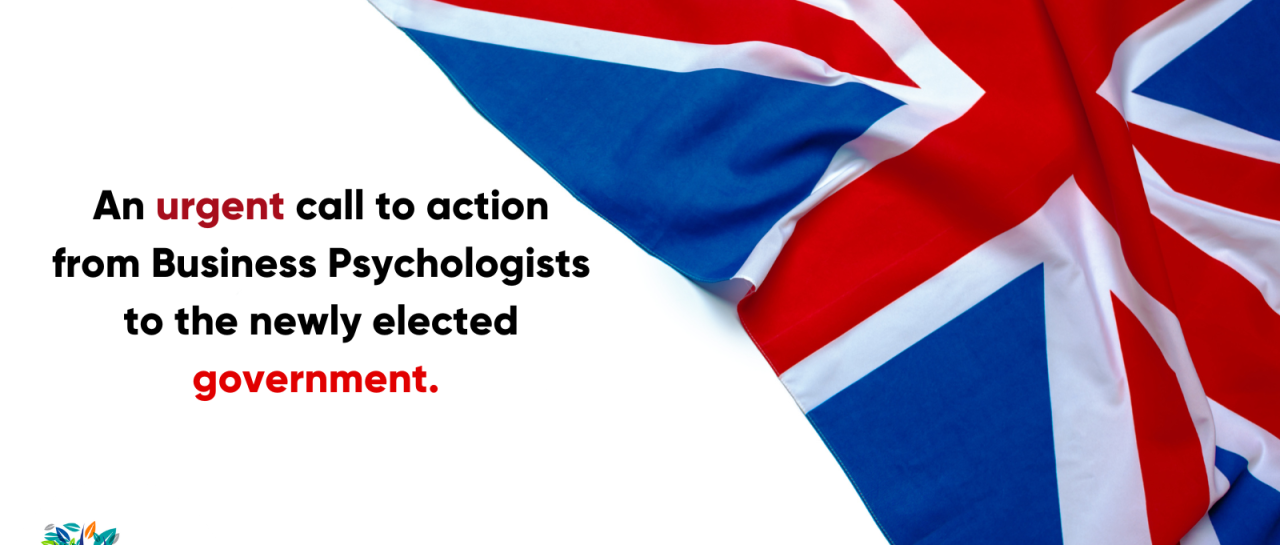Authored by Certified Business Psychologist Laura Howard. Certified Business Psychologist, Laura Howard, reflects on the webinar she recently delivered to ABP members. Below she outlines the main findings of her published research uncovering systematic barriers women face when being authentic as leaders. Importantly, she gives…
On 23rd January the ABP joined with Engage 4 Success and other interested parties to hold an event exploring employee engagement, hosted by Eversheds LLP, Manchester.
Our speakers included:
- Ivan Robertson presenting his work on Psychological Wellbeing and Employee Engagement;
- Tess Shannon on how Engage4Success has made a difference at the Cooperative Group
- Lee Ashwood from Eversheds discussing the legal framework around employee engagement.
Read on for a summary of each presentation, with many thanks to each of our speakers and to Eversheds for hosting the event.
Professor Ivan Robertson, co-founder Robertson Cooper and Professor Emeritus, Manchester Business School
Ivan Robertson has worked in an academic and professional business environment for many years and we were privileged to hear of his lifetime of experiences in the industry, particularly in the area of psychological wellbeing and employee engagement at work.
Providing background to work in this area, Ivan reported on practitioner activity which has shaped thinking in the understanding of what motivates engagement – from macro environmental factors such as citizenship in communities and job/role commitment to encouraging people to “Go the Extra Mile” and “turning over every Stone”. Work by David MacLeod which was enshrined in the Government sponsored report “Engage for Success” brought much of this material together.
Researchers have highlighted Work Involvement Models, which describe the importance of high concentration, absorption, vigour, encouraged by mental resilience and dedication, from a sense of pride and challenge. Although there is no agreed definition of engagement most prevalent models of employee engagement include some or all of six different attributes:
- Discretionary effect
- Commitment
- Organisational Citizenship
- Attachment
- Sense of Purpose
- Alignment of goals and culture between individuals and the organisation
PWB is all about the extent to which people experience a positive sense of wellbeing in their work and the positive emotions. It is not simply about reducing pressure: it is about the appropriate degree of stress levels to optimise performance which can vary from individual to individual.
Virtually all organisations would agree that wellbeing of employees is now regarded as of strategic importance. After all, one of the most effective risk reduction initiatives involves ensuring the reduction of sickness absence and organisations can make a huge difference by addressing the causes of absence. For example, minor illnesses account for 95% of short term absence, but surprisingly 47% is accounted for by stress, and this rises to 53% for long term absence and is the main cause of long term absence.
How should organisations address the need for wellbeing initiatives? Many fall into the trap of believing that they can be simply bundled together and that outward bound or group yoga activity will solve sickness absence issues. The problem is that such solutions are not evidenced based and are not linked to specific business outcomes. A more sustainable approach is for organisations to look at positive outcomes, such as improved performance, “attachment”, organisational citizenship, and making a contribution to innovation and creativity as a path to maximising wellbeing. Any solution has to work for both employers and employees.
Linking psychological wellbeing to work performance is way forward to a more evidence based approach. Researchers have additionally linked individual work performance to organisational performance and found a 12% increase in performance as a result of achievable individual levels of wellbeing.
PWB also has an effect on increased life span, healthy behaviour, better cardiovascular health, and a reduced risk of diabetes. The evidence is compelling: 11 out of 11 studies demonstrated Cardiovascular Disease could be stress induced and in excess of 30% of instances are estimated to be health induced, manifested in the form of heart attacks, diabetes, obesity and a range of effects from minor heart attacks to serious illnesses.
Until the MacLeod report, there was a relatively narrow view of engagement, focusing on commitment, attachment, sense of purpose and “organisational citizenship”. The understanding has now been widened to include positive emotions, resilience, energy and PWB. To illustrate the point, Robertson Cooper has found that there is a 0.2 correlation between traditional models of engagement and productivity and this doubles to a 0.41 correlation when “Engaged and Well” including PWB is considered.
Achievement is a complex concept to measure but what is without doubt is that cognitive, physical and emotional overload is can lead to stress, underperformance and worse. Having some degree of autonomy and control, along with support mechanisms can transform a working environment. It is important to understand that it is a commonplace belief that wellbeing and performance are in conflict with each other but this needs to managed so that the appropriate tension and balance can drive the organisation to better overall performance. Role ambiguity, work relationships and job insecurity can act as a hindrance and need to be handled strategically whereas job scope, responsibility, time pressure and workload can provide challenges and be positive when they are matched by appropriate objectives and support.
Clearly “Drift” is not an option, and organisations need appropriate and selective interventions. These can only improve efficiency and effectiveness if they have strategic and operational goals which should be drawn up against the background of desired benefits.
A mistake which organisations commonly make is that there is insufficient analysis of and consideration given to current workplace factors, wellbeing and engagement levels and absence and productivity factors
These concepts are enshrined in the “ASSET” Measurement Model devised by Robertson Cooper and collaborators. This is an evidence based approach which links the six essentials of Workplace Wellbeing to PWB and five key desired outcomes which include productivity, employee engagement, commitment, physical health and psychological health. Although having the characteristics of a survey, the information gathered is specific to employees and therefore of specific use to the business.
Insights from this information cover:
- organisational level insights, including overview, benchmarks and demographics analysis
- results for line managers,
- immediate feedback through personalised wellbeing snapshot reports
Key features include:
- Organisation level results
- various aspects of organisational capacity,
- important operational highlights including those who can be identified as wellbeing champions
Other features include the ongoing issues of management and leadership, looking at everything from strategy and resilience to employee mental health, all based on expert testimony and research evidence. At the heart of this is building management capability, which, in addition to traditional training and development, covers areas such as workshops, enabling support for teams under particular pressure and improving their resilience and their performance.
What the organisation needs to address, however, before embarking on any wellbeing programme, is clear identification of the challenges. “Wellbeing” initiatives can be met with cynicism and scepticism and there should be clear definitions of ownership and goals which everyone can buy into. Once this has been done measures can be taken to build individual capabilities such as management skills and confidence and resilience.
In summary, a wellbeing programme should
- Have a clear ROI
- Have a multi-function approach
- explode the myth that wellbeing and performance are always in destructive conflict
- recognise that an investment in wellbeing can easily be derailed and the organisation should be ready
- ensure that all interventions are evidence based
Click here to view Ivan’s presentation slides
Tess Shannon, Colleague Engagement and Business Partner, The Cooperative Group
Engage 4 Success was born in 2009 as a result of the Employee Engagement (EE) Report with the name “Engage for Success”, compiled by David MacLeod and his team. It was launched as a forum for organisations to share their experiences and commitment and demonstrate advocacy and motivation. In addition it provides practical tools and ideas.
Why did it matter? In broad terms, if an organisation embraced EE, then 42% experience to a greater or lesser extent an improvement in performance. But other issues such as level of sales and sickness absence can have a significant bearing.
There are four drivers and enablers of strategic engagement
- The Strategic Narrative
- Engaging Managers
- Employee Voice, covering new initiatives, including 2 way dialogue
- Enforcing organisational integrity, including the concept of psychological contract, covering implicit expectations at work
E4S has been established following a task force in alliance with CIPD and is a voluntary movement. Its guiding principles are inclusion, practicability, forward thinking, good tools / guidance for organisations. In short E4S is about recognising the need for change and meeting the challenge.
How has E4S made a contribution to the revitalisation of the Coop?
The Coop is an organisation of 70,000 people covering a diverse range of businesses, a funeral director, a legal service along with the well known grocery businesses. It is member owned, and member led.
While the 2013 crisis was painful for the organisation, it provided the opportunity to restore slips in governance and to rebuild the brand. Rather than doing this around different business units or operations it adopted a people first focus because the organisation would not be able to change “without their engagement”. It adopted a series of inputs and outputs from its core brand. Using ways of being, freedom formula, the “One Coop Identity” and the large membership base, it could look forward to unifying in a single brand a sense of purpose around members, colleagues, communities and customers.
This employer brand rebuilding took their people to focus on three main areas:
- ways of identifying with or “being” Coop
- Being a Coop founder
- Back to being a Coop, enshrining the embodiment of sustainability
The image of sustainability is about doing what matters most and “being yourself” always. It is about:
- Succeeding, with a big brand and new products
- Doing it together, launching at the AGM
- encouraging employees to attend facilitated events hosted by leaders
“Back to being Coop” events was reminiscent of scout huts etc events, but what was particularly important was that it reflected the International Co-operative Alliance ICA) set of values. A survey of 167,000 colleague responses and 111,000 member responses were distilled down into 37 words and 7 themes which helped to identify four territories.
The following messages were then communicated to all 70,000 employees at 5100 sessions/events held nationally:
- Do what matters most, always
- Be yourself, always
- Succeed together
- Show you care
Separate sessions were held for leaders, with 5200 attending 58 events in 23 locations.
By the end of the programme, 100% of people understood why changes were happening in the business and 95% of people understood the purpose and strategy of the Coop. Other benchmarked data showed a huge increase in engagement.
The rebranding also provided an opportunity to reduce the 37 behavioural frameworks, with the emphasis on the “How” rather than the “What”
So, where is the Coop today?
- It is in the advance stage of its “Renew” phase although this is an ongoing process
- Less transactional and more of a transformational mindset
- more concerned with Engagement – behavioural/dialogue. It more frequently listens to employees and strings together information from its annual surveys of employees
- more ambition, reflecting a stronger Coop, being proud to be part of and be close to stronger communities
- It is more of an “enabling organisation” which sits with and brings its colleagues along with it rather than “marketing” to them
- More focus on leadership, with clearer lines of accountability
In summary, the association with E4S is highly relevant. The organisation is a case study in how strenuous efforts and appropriately focused activity have been made to improve productivity through employee engagement. Common principles apply in a given context, with a focus on leadership, integrity and sustainability and taking responsibility by doing and behaving within the boundaries and guidelines of the new culture.
Click here to view Tess Shannon’s presentation slides
Lee Ashwood – Senior Associate, Eversheds
The purpose of this presentation was to introduce the event and explore the legal framework around employee engagement and provide pointers to future legislation in this area.
The presentation looked at what issues employers should be addressing in order to be compliant and what the desired outcomes should be.
It is often forgotten in our busy working lives that hiring an employee carries with it substantial legal obligations which go beyond obvious issues such as employment contracts.
The main areas of relevant legislation are:
- Health and Safety
- Discrimination, as enshrined in the Equality Act 2010
- Data protection, as updated by the GDPR legislation
Additionally, organisations are advised to have a diversity and inclusion (D&I) policy which can demonstrate to employees and others who may wish to scrutinise the organisation that they are serious about inclusion at all levels.
While most of the legislation is commonsense and not over burdensome, it can be used as a basis for best practice and minimisation of causes of friction and stress. Many successful organisations, for example address discrimination by having a policy of D&I and this has a positive outcome because it creates mutual trust and confidence.
The world is changing and perception is critical, from shareholders to buyers. It is well known that an organisation, should it have the misfortune to be faced by a tribunal, fares better when it has demonstrated its commitment to having policies and adhering to them. It also ensures that adverse press reports are kept to a minimum.
The non-legal aspects of forward thinking and productivity improvements have become more critical than whether the organisation is compliant.
In terms of employee engagement, organisations which view people as assets to be properly managed rather than consumables, find that they can raise productivity, creativity and levels of innovation, added to big reductions in staff turnover. But the key ingredient is trust and buy in from employees: trust between the organisation and its clients, trust between staff and management and trust between peers. This can not be enforced by legislation, but a sound basis of compliance goes a long way towards building it.




